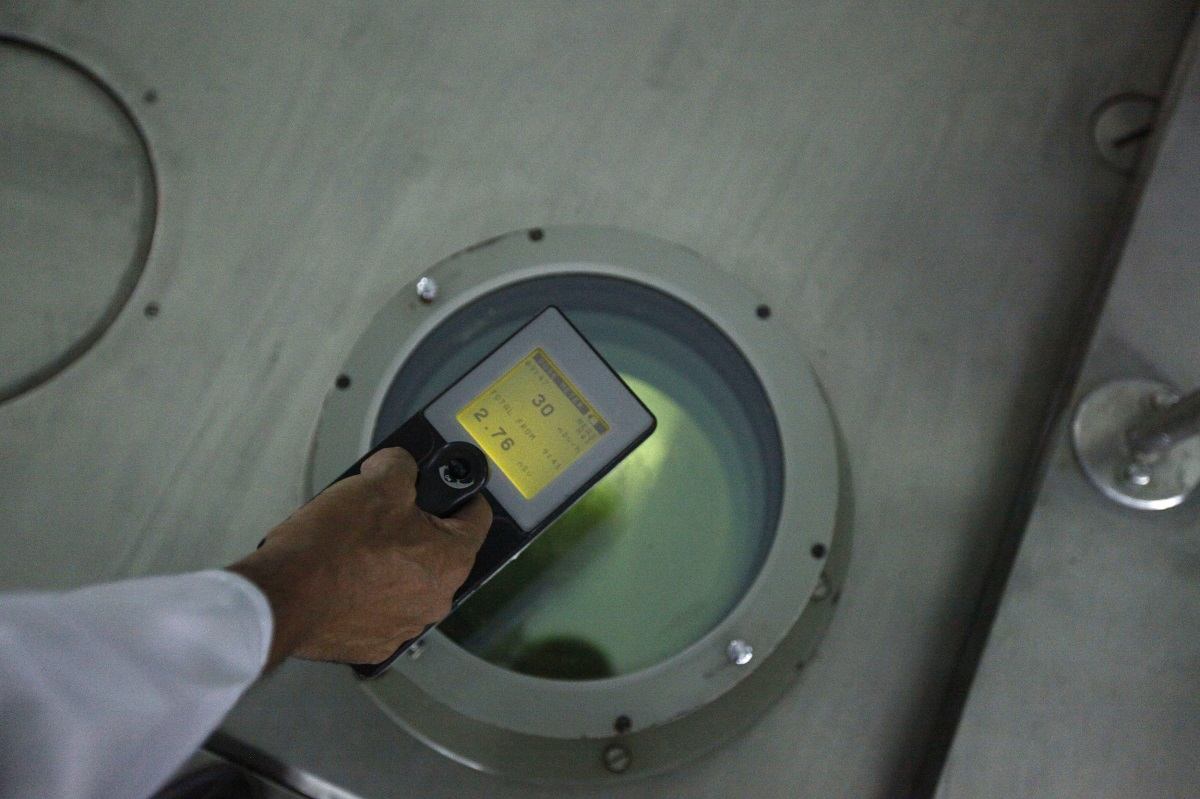
A Libyan representative uses a Geiger counter to measure radiation at the Tajoura nuclear research center in Tripoli September 5, 2011.
11:26 JST, March 17, 2023
DUBAI, United Arab Emirates (AP) — Some 2.5 tons of natural uranium stored in a site in war-torn Libya have gone missing, the United Nations nuclear watchdog said Thursday, raising safety and proliferation concerns.
However, forces allied to a warlord battling the Libyan government based in the capital of Tripoli claimed on Thursday night that they recovered the material. U.N. inspectors said they were trying to confirm that.
Natural uranium cannot immediately be used for energy production or bomb fuel, as the enrichment process typically requires the metal to be converted into a gas, then later spun in centrifuges to reach the levels needed.
But each ton of natural uranium — if obtained by a group with the technological means and resources — can be refined to 5.6 kilograms (12 pounds) of weapons-grade material over time, experts say. That makes finding the missing metal important for nonproliferation experts.
In a statement, the Vienna-based International Atomic Energy Agency said its director-general, Rafael Mariano Grossi, informed member states Wednesday about the missing uranium.
The IAEA statement remained tightlipped though on details.
On Tuesday, “agency safeguards inspectors found that 10 drums containing approximately 2.5 tons of natural uranium in the form of uranium ore concentrate were not present as previously declared at a location in the state of Libya,” the IAEA said. “Further activities will be conducted by the agency to clarify the circumstances of the removal of the nuclear material and its current location.”
The IAEA did not identify the site, nor did it respond to questions about it from The Associated Press.
Reuters first reported on the IAEA warning about the missing Libyan uranium, saying the IAEA told members reaching the site that’s not under government control required “complex logistics.”
One such declared site is Sabha, some 660 kilometers (410 miles) southeast of Tripoli, in the country’s lawless southern reaches of the Sahara Desert. Libya’s late dictator Moammar Gadhafi stored thousands of barrels of so-called yellowcake uranium for a once-planned uranium conversion facility that was never built in his decadeslong secret weapons program.
Estimates put the Libyan stockpile at some 1,000 metric tons of yellowcake uranium under Gadhafi, who declared his nascent nuclear weapons program to the world in 2003 after the U.S.-led invasion of Iraq.
But the 2011 Arab Spring saw rebels topple Gadhafi and ultimately kill him. Sabha grew increasingly lawless, with African migrants crossing Libya, saying some had been sold as slaves in the city, the U.N. reported.
In recent years, Sabha largely has been under the control of the self-styled Libyan National Army, headed by Khalifa Hifter. On Thursday night, Hifter’s forces issued a statement claiming they had recovered the material.
They published a video showing a man in a disposable white suit and respirator in the desert, counting off what appeared to be 18 metal drums. Some of the blue-painted drums bore what appeared to be batch numbers. News footage from 2011 of the facility showed similar drums.
However, the man did not open the drums in the footage.
Hifter’s forces claimed they found the drums some 5 kilometers (3 miles) south of the facility. They tried to accuse Chadian separatist fighters, who operate in the region, of stealing the drums after mistaking them for weapons and ammunition. Hifter’s forces provided no evidence for the accusation.
The video footage resembled features of the desert surrounding the uranium stockpile site, though the AP could not immediately locate it.
Hifter’s forces also claimed the storage site had been found with an “opening” on its side. They claimed that a top IAEA official informed them of the “opening” nearly a week earlier than the agency described discovering the missing uranium. The conflicting timelines could not be immediately reconciled.
Hifter’s forces also asserted the IAEA failed to provide protective equipment and security for the site, though countries with nuclear material themselves bear responsibility for those sites. They also didn’t explain how the site had been secured — or if it was currently.
Asked about the claim by Hifter’s forces, the IAEA said: “We are aware of media reports that the material has been found. The agency is actively working to verify them.”
While inspectors removed the last of the enriched uranium from Libya in 2009, the yellowcake remained behind, with the U.N. in 2013 estimating some 6,400 barrels of it were stored at Sabha. American officials had worried Iran could try to purchase the uranium from Libya, something Gadhafi’s top civilian nuclear official tried to reassure the United States about, according to a 2009 diplomatic cable published by WikiLeaks.
“Stressing that Libya viewed the question as primarily a commercial one, (the official) noted that prices for uranium yellowcake on the world market had been increasing, and that Libya wanted to maximize its profit by properly timing the sale of its stockpile,” then-Ambassador Gene A. Cretz wrote.
"News Services" POPULAR ARTICLE
-

American Playwright Jeremy O. Harris Arrested in Japan on Alleged Drug Smuggling
-

Japan’s Nikkei Stock Average as JGB Yields, Yen Rise on Rate-Hike Bets
-

Japan’s Nikkei Stock Average Licks Wounds after Selloff Sparked by BOJ Hike Bets (UPDATE 1)
-

Japanese Bond Yields Zoom, Stocks Slide as Rate Hike Looms
-

Japan’s Nikkei Stock Average Buoyed by Stable Yen; SoftBank’s Slide Caps Gains (UPDATE 1)
JN ACCESS RANKING
-

Keidanren Chairman Yoshinobu Tsutsui Visits Kashiwazaki-Kariwa Nuclear Power Plant; Inspects New Emergency Safety System
-

Imports of Rare Earths from China Facing Delays, May Be Caused by Deterioration of Japan-China Relations
-

University of Tokyo Professor Discusses Japanese Economic Security in Interview Ahead of Forum
-

Japan Pulls out of Vietnam Nuclear Project, Complicating Hanoi’s Power Plans
-

Govt Aims to Expand NISA Program Lineup, Abolish Age Restriction

























